Weekly Fishing Report: December 6
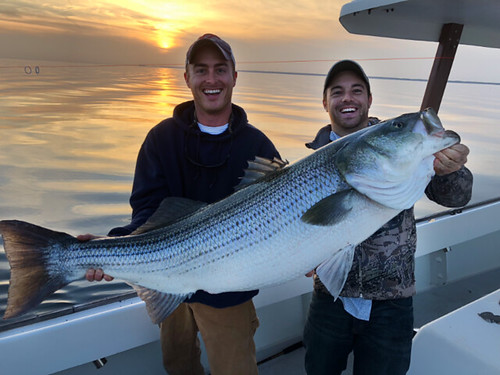
This 51-inch fish was caught in Eastern Bay while trolling a spoon, and was quickly released. Photo courtesy of Bradley Smith
The striped bass fishing community always anticipates the possible appearance of large fall migrant striped bass in our portion of the Chesapeake Bay.
The fall migration was late this year, but the first confirmed report came in over the weekend — so there is hope for anglers wishing to catch a trophy-sized striped bass before our season closes on Dec. 20.
Trolling along channel edges close to the bottom in 35 feet of water or more tends to be the most popular way to fish for larger striped bass this week. A mix of swim shads, bucktails, red surge tube lures and spoons are being used in tandem or behind umbrella rigs; inline weights are needed to get presentations down close to the bottom. Now that large fall migrant striped bass may come in to play, it pays to place at least one large bait out in a trolling spread, perhaps a large parachute or spoon.
Before we get into this week’s fishing report, I wanted to remind everyone that they can submit their own fishing reports and photos to the Maryland Angler’s Log. To post a report, please email your name, hometown, photos, location information and additional content for your report. All information is optional, but encouraged. New reports are posted daily during the busy fishing seasons.
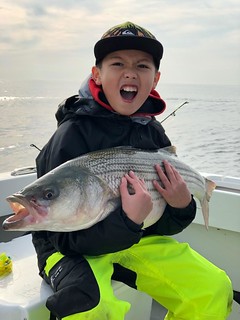
Eleven-year-old Owen Salanik is happy with this fine-looking striped bass he caught while fishing below the Bay Bridge with his dad. Photo by Steve Salanik
Jigging over suspended fish is still an option where they can be found holding along channel edges in the upper bay region — locate them with a depth finder. Large soft plastic jigs in the 8-inch or better size have been popular. Water temperatures have dipped below the 50 degree mark this week, and striped bass in the 16-inch size range are slowing down, not feeding as heavily and holding deep. The deeper bridge piers and rock piles at the Bay Bridge, in 40 feet or more of water, have been an excellent place to jig for a mix of striped bass and large white perch. At times the smaller striped bass can be fairly pesky when they are stacked down deep like cord wood, so most are using large 8-inch soft plastic jigs when fishing for striped bass. The white perch are being caught with dropper flies on a bottom rig — of course, the small striped bass will hit them also, which can cost a lot of time and effort.
At the mouth of the Susquehanna River, there has been good fishing for striped bass that are mostly under the 20-inch mark, but still a lot of fun on light tackle. There has been a large number of young of the year shad and river herring coming down the river, which has attracted the attention of the striped bass. Casting shad-looking crankbaits tends to be the most popular way to fish, and a mix of walleye and smallmouth bass are also being caught in the river.
Below the Bay Bridge, the middle region of the bay has been offering good trolling opportunities for resident striped bass along with the chance of catching a trophy fall migrant striped bass. The best trolling has been along the western edge of the shipping channel from Thomas Point south to Breezy Point along the 40 foot edge. A mixed spread of both medium and large parachutes, swim shads and spoons have been popular in tandem or behind umbrella rigs, all with inline weights to get them down deep where the fish are holding.
Surface water temperatures are about 50 degrees this week in the bay and slightly warmer closer to the bottom. Resident striped bass above 20 inches and below, along with white perch are all holding deep now, looking for slightly warmer waters. The striped bass are mostly out in the main channels of the bay and the white perch are at the mouths of the tidal rivers and steadily moving into the deeper waters of the bay.
In the lower bay region much of the best striped bass fishing is occurring in the lower Potomac River along the steep channel edge from St. Georges Island south to Point Lookout in about 40 feet of water. The larger fish are holding close to the bottom so inline weights are needed when trolling. A mix of medium and large size parachutes, swim shads and spoons have been the lures of choice in tandem or behind umbrella rigs. The approach channel from Smith Point upriver to the green No. 9 buoy has been a good place to troll as well as below the “target ship” and buoys 68 and 72. These are also good areas to jig with large, soft plastics, wherever depth finders locate fish suspended close to the bottom.
There still tends to be some topwater striped bass action in the lower Patuxent River and near the Hooper’s Island cuts this week, but the last of these smaller striped bass will be going deep soon. White perch are holding deep in the lower Patuxent, Nanticoke and Wicomico rivers in about 40 feet of water over hard oyster bottom. Bottom rigs baited with pieces of bloodworm or dropper flies on a bottom rig are the best way to catch the white perch.
Weekly Tidal Fishing Conditions Forecast – Dec. 6-13
Colder conditions for this first full week of December should result in dropping surface water temperatures for bay gamefish continuing their movement out of river mouths and down the bay, and also those fish staying in Maryland waters to winter. The Maryland portion of the bay continues to have a well-mixed water column with suitable oxygen conditions from surface to bottom. However, there are slightly warmer bottom water temperatures so anglers may want to scan these deeper channel areas for fish.
Main bay surface water temperatures are hovering at the low 50s/upper 40s with the coolest waters found in the upper bay and upper Potomac River near the Woodrow Wilson bridge. The warmer waters are found from the Gooses Reef south (51 degrees) to the mouth of the Potomac River (52 degrees). Expect some reduced water clarity from recent algal blooms in the Patapsco River, the lower Potomac near Cobb Island and in the Bush and the upper Back River. Patchy areas of algal blooms are also present on the mainstem of the bay from near the Bay Bridge down to the Rhode River. Expect normal to below normal flows for streams and rivers entering Maryland’s portion of the bay. There will be excellent tidal currents conditions Wednesday through Friday as a result of the recent full moon.
For the full weekly fishing conditions summary and more detailed and up-to-date fishing conditions in your area of the bay, be sure to check out Eyes on the Bay’s Click Before You Cast. Since this is a new feature for Chesapeake Bay anglers, drop us a line with comments or suggestions.
Cold water conditions at Deep Creek Lake have really kicked the walleye and yellow perch fishing into high gear. Some nice walleye are being caught along steep rocky edges, bridge piers and the dam face at the popular reservoir. Drifting minnows down deep tends to be one of the favorite ways to catch a mix of walleye and large yellow perch. Casting diving jerkbaits and crankbaits in the evenings from shore is also an excellent way to fish for walleye.
Fishing for walleye has also been good in the upper Potomac River, although higher flows would help improve fishing. Working light swimbait-type jigs close to the bottom has been a good tactic. Fishing for smallmouth bass has dropped off due to colder water temperatures, but these fish can still be caught in some of the deeper holes with light jigs worked slow on the bottom.
Farther down the Potomac, in its tidal portion, largemouth bass can be found along some of the deeper edges and near deep hard cover. Small jigs and grubs are two of the better choices for lures and some anglers are beginning to use blade lures in the deeper locations. Fishing for blue catfish in the channels is very good and it is not hard to fill up a large ice chest with some good-eating blue cats. A simple one-hook bottom rig and fresh-cut bait is all that is needed. For anglers without a boat, the channel comes close to the bank at Fort Washington Park and offers a good place to bank fish for blue catfish.
Trout fishing right now is mostly a game of imitating natural food items for these fish – like nymphs and small baitfish. The trout management areas that have regulated catch-and-release and fly-fishing only offer the best opportunities for some coldwater trout fishing fun. The put-and-take areas might be considered mostly taken, but there are always a few trout that seem to dodge bait fishing. Casting small spinners is a good way to cover a lot of water and entice a holdover trout to strike.
Fishing for crappie continues to be very good this week in a variety of locations. Small dam pools at spillways are always a good bet. Fallen treetops in ponds and lakes or tidal rivers make good locations to check, as are marina docks and piers. Small jigs or minnows under a slip bobber is the best way to fish for them. The Nicodemus Road Bridge at Liberty Reservoir has a sister fishing pier running parallel and presents a great place to fish for crappie near the bridge piers.
Fishing for chain pickerel is always good this time of year in ponds, lakes and tidal rivers throughout most of Maryland. These fish love cold water and feed during the colder months, and with grass beds diminished they tend to be more accessible. Spinners, spoons and jerkbaits are just a few of the lures that are good choices for chain pickerel fishing.
Yellow perch are becoming more common in the upper regions of the bay’s tidal rivers, and minnows provide one of the best ways to catch them. Channel catfish are very active this time of the year and just about every tidal river has a good population of them. Cut bait on a simple bottom rig is all that is needed to catch these cats. A nice piece of shoreline, a good seat, some snacks and a good friend helps round out the experience.
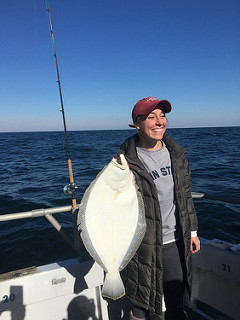
This angler is certainly all smiles with this beautiful flounder she caught on an Ocean City party boat. Photo courtesy of Monty Hawkens
The coastal region is starting to feel the cold grasp of winter as water temperatures near Ocean City drop to below the 50 degree mark. Surf casters are patiently fishing with large cut baits in the surf, hoping to hook up with a large striped bass hugging the Maryland shoreline while heading south. Others have been trolling outside the inlet near shoal areas but the nearest reports of large fish being caught are coming from Cape May, New Jersey and a few from outside Indian River Inlet.
The best action to be found outside of the inlet is the fishing scene out at the wreck and reef sites where rail huggers are catching sea bass and a mix of large flounder, small bluefish and even a few Atlantic mackerel. The throwback ratio on the sea bass is high and apparently at some locations the throwback ratio of spiny dogfish is even higher. This is the time of the year when horndoggers, as they are commonly called, can be really pesky bait stealers.
Inside the Ocean City Inlet there has been some fun light-tackle fishing for striped bass that fall short of the 28-inch minimum but offer a lot of fun fishing with swimshads and topwater lures. They can be found from the inlet into the back bay areas to the Route 90 Bridge area.
“In the autumn, fishing is coming to an end and each day you are parting with it – for a long time, for a whole six months.” – Sergi Aksakov
 ABOUT THE AUTHOR Keith Lockwood has been writing the Fishing Report since 2003 and has had a long career as a fisheries research biologist since 1973. Over the course of his career he has studied estuarine fishery populations, ocean species, and over a decade long study of bioaccumulation of chemicals in aquatic species in New Jersey. Upon moving to Oxford on the eastern shore of Maryland; research endeavors focused on a variety of catch and release studies as well as other fisheries related research at the Cooperative Oxford Laboratory. Education and outreach to the fishing public has always been an important component to the mission of these studies. Keith is an avid outdoorsman enjoying hunting, fishing, bird dogs, family and life on the eastern shore of Maryland.
ABOUT THE AUTHOR Keith Lockwood has been writing the Fishing Report since 2003 and has had a long career as a fisheries research biologist since 1973. Over the course of his career he has studied estuarine fishery populations, ocean species, and over a decade long study of bioaccumulation of chemicals in aquatic species in New Jersey. Upon moving to Oxford on the eastern shore of Maryland; research endeavors focused on a variety of catch and release studies as well as other fisheries related research at the Cooperative Oxford Laboratory. Education and outreach to the fishing public has always been an important component to the mission of these studies. Keith is an avid outdoorsman enjoying hunting, fishing, bird dogs, family and life on the eastern shore of Maryland.
Want the Weekly Fishing Report sent right to your inbox? Click here to sign up!

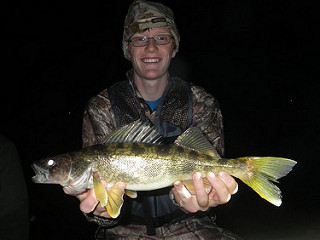
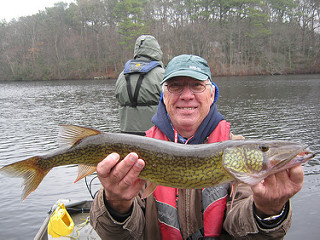
 1-888-373-7888
1-888-373-7888 233733
233733